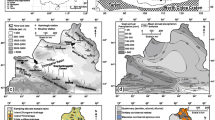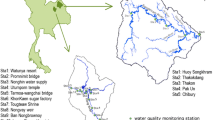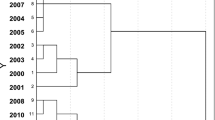Abstract
Many studies group hydrochemical datasets into hydrochemical facies using graphical and multivariate statistical methods. Compared to graphical methods, cluster analysis and principal component analysis (PCA) can handle large datasets and great number of parameters, so are widely used by researchers. However, cluster analysis and PCA can be subjective, raising questions about the significance and confidence of the groupings. In this study, cluster analysis is combined with multiple discriminant function analysis and measures of association (Cohen’s Kappa and Cramer’s V) to objectively find the optimum clustering technique, number of clusters for a hydrochemical dataset, and stable clusters, and to assess the effect of hydrochemical data transformation, analytical errors, and outliers on a clustering outcome. The proposed combined statistical and mathematical analysis is a robust approach for classifying hydrochemical dataset into optimum hydrochemical facies. The approach is used to demonstrate that the best clustering method for the hydrochemical data from the Lower Virgin River Basin, utilized in this study, is the “within-groups linkage with squared Euclidean distance” clustering method, yielding six optimum hydrochemical facies. The six optimum hydrochemical facies solution is independently supported by test statistical analyses that are used for deciding the number of plausible clusters. Also the application shows that choosing an appropriate data transformation is a key step in delineating optimum hydrochemical facies. Further, it is demonstrated that the effect of outliers and analytical errors on clustering is insignificant when the dataset contains outliers \(\le \)7 % or analytical error \(\le \)19 %. Interpretations of the spatial and graphical analysis of the hydrochemical facies reveal that principal recharge in the study area occurs in the Clover and Bull Mountains and Valleys as well as areas further north. Also the analysis indicates that Virgin River and Beaver Dam Wash water possibly recharges their adjacent floodplains. In an agreement with previous studies in hydrogeology of the study area, the new approach demonstrably is consistent, reproducible, and validated for identification of recharge distribution over large basin areas.



Similar content being viewed by others
References
Ashley RP, Lloyd JW (1978) An example of the use of factor analysis and cluster analysis in groundwater chemistry interpretation. J Hydrol 39(3–4):355–364
Bacher J (2001) Teststatistiken zur Bestimmung der Clusterzahl für Quick Cluster. ZA Inf/Zent Emp Sozial 4871–4897
Back W (1961) Techniques for mapping of hydrochemical facies. In: Hydrogeology P0424-D, U.S. Geological Survey, Reston, pp. D380–D382
Bassett R, Steinwand A, Jorat S, Petersen C, Jackson R (2008) Forensic isotope analysis to refine a hydrologic conceptual model. Ground Water 46(3):372–383
Bateman RL (1976) Inventory and chemical quality of ground water in the white river–muddy river–meadow valley wash area, southern Nevada. In: Project No. 40, Water resources Center Desert Research Insitute, University of Nevada Systems, Nevada
Bohannon RG, Grow JA, Miller JJ, Blank Jr RH (1993) Seismic stratigraphy and tectonic development of Virgin River depression and associated basins, southeastern Nevada and northwestern Arizona. Geol Soc Am Bull 105(4):501–20
Brothers K, Katzer T, Mojib RM, Grinnell G, Bernholtz A, Johnson M (1993) Addendum to hydrology and interactive computer modeling of ground and surface water in the lower Virgin River Valley, primarily in the Clark County Nevada. 1-A, Las Vegas Valley Water District, Cooperative Water Project, Las Vegas
Bushman M, Nelson ST, Tingey D, Eggett D (2010) Regional groundwater flow in structurally-complex extended terranes: an evaluation of the sources of discharge at Ash Meadows, Nevada. J Hydrol 386(1–4):118–129
Carrillo-Rivera JJ, Clark ID, Fritz P (1992) Investigating recharge of shallow and paleo-groundwaters in the Villa de Reyes Basin, SLP, Mexico, with environmental isotopes. Appl Hydrogeol 1(4):35–48
CEMP (2011) Community Environmental Monitoring Program (CEMP). A joint program between the Department of Energy’s (DOE) National Nuclear Security Administration Nevada Site Office (NNSA/NSO), and the Desert Research Institute (DRI) of the Nevada System of Higher Education. http://www.cemp.dri.edu/cemp/. Accessed 21 April 2011
CH2M HILL(2002) Focused hydrological assessment of the Tule Desert hydrographic area including relevant aspects of the Virgin River hydrographic area in Southern Nevada. Toqoup Energy Inc, Nevada
Chapelle FH (2005) Geochemistry of groundwater. In: Holland HD, Turekian KK (eds) Surface and ground water, weathering, and soils (ed. Drever JI), vol 5. Treatise on geochemistry. Elsevier Pergamon, Oxford, pp 425–449
Cloutier V, Lefebvre R, Therrien R, Savard MM (2008) Multivariate statistical analysis of geochemical data as indicative of the hydrogeochemical evolution of groundwater in a sedimentary rock aquifer system. J Hydrol 353(3–4):294–313
Cohen J (1960) A coefficient of agreement for nominal scales. Educ Psychol Meas 20(1):37–46
Dalton MG, Upchurch SB (1978) Interpretation of hydrochemical facies by factor analysis. Ground Water 16(4):228–33
Demlie M, Wohnlich S, Wisotzky F, Gizaw B (2007) Groundwater recharge, flow and hydrogeochemical evolution in a complex volcanic aquifer system, central Ethiopia. Hydrogeol J 15(6):1169–1181
Deutsch WJ (1997) Groundwater geochemistry: fundamentals and applications to contamination. Lewis Publishers, Boca Raton
Dixon GL, Katzer T (2002) Geology and hydrology of the lower Virgin River Valley in Nevada, Arizona, and Utah. VVWD-01, Virgin Valley Water District, Nevada
Dreher T (2003) Comment on Güler C, Thyne GD, McCray JE, Turner AK (2002): evaluation of graphical and multivariate statistical methods for classification of water chemistry data (Hydrogeology Journal 10:455–474). Hydrogeol J 11(5):605–606
Earth Point (2009) Township and Range—Public Land Survey System on Google Earth. http://www.earthpoint.us/Townships.aspx. Accessed 20 October 2009
Enright M (1996) Selected hydrologic data for the Beaver Dam Wash area, Washington County, Arizona, 1991–1995. In: Open-File 96-493, United States Geological Survey, p 36
Everitt BS, Landau S, Leese M, Stahl D (2011) Cluster analysis, 5th edn. Wiley, Great Britain
Feuerstein W, Grimm-Strele J (1989) Plausibilitätstests für eine routinemäßige Erfassung von Grundwasserbeschaffenheitsdaten. Vom Wasser 73375–73398
Garrels RM, Mackenzie FT (1967) Origin of the chemical compositions of somesprings and lakes, Chapter 10. Equilibrium concepts in natural watersystems. In: American Chemical Society 151st annual meeting, Pittsburgh, 1966, Division of Water, Airand Waste chemistry symposium, pp 222–242
Glancy PA, Van Denburgh AS (1969) Water-resources appraisal of the lowerVirgin River Valley area, Nevada, Arizona, and Utah. State of Nevada,Division of Water Resources, Carson City
Gong X, Richman MB (1995) On the application of cluster analysis to growing season precipitation data in North America east of the rockies. J Clim 8(4):897–931
Gordon AD (1999) Classification, 2nd edn. Chapman & Hall/CRC, Boca Raton
Gross AL (1972) A Monte Carlo study of the accuracy of a hierarchical grouping procedure. Multivar Behav Res 7(3):379–389
Güler C, Thyne GD (2003) Reply to comment by T. Dreher to Güler C, Thyne GD, McCray JE, Turner AK (2002) evaluation of graphical and multivariate statistical methods for classification of water chemistry data (Hydrogeology Journal 10:455–474). Hydrogeol J11(5):607–608
Güler C, Thyne GD (2004) Hydrologic and geologic factors controlling surface and groundwater chemistry in Indian Wells-Owens Valley area, southeastern California, USA. J Hydrol 285(1–4):177–198
Güler C, Thyne GD, McCray JE, Turner AK (2002) Evaluation of graphical and multivariate statistical methods for classification of water chemistry data. Hydrogeol J 10(4):455–474
Heath RC (1984) Ground-water regions of the United States. U.S. Department of the Interior, Geological Survey, Washington, DC
Helstrup T, Jørgensen N, Banoeng-Yakubo B (2007) Investigation ofhydrochemical characteristics of groundwater from the Cretaceous-Eocenelimestone aquifer in southern Ghana and southern Togo using hierarchicalcluster analysis. Hydrogeol J 15(5):977–989
Hem JD (1989) Study and interpretation of the chemical characteristics of natural water. In: Water-supply paper 2254, United States Geological Survey, United States Government Printing Office, Washington, DC, pp 1–263
Hershey RL, Mizell SA, Earman S (2010) Chemical and physical characteristics of springs discharging from regional flow systems of the carbonate-rock province of the Great Basin, western United States. Hydrogeol J 18(4):1007–1026
Hounslow A (1995) Water quality data: analysis and interpretation. Lewis Publishers, Boca Raton
Howarth R, Earle S (1976) Application of a generalized power transformation to geochemical data. Math Geol 11(1):45–62
Ingraham NL, Zukosky K, Kreamer DK (2001) Application of stable isotopes to identify problems in large-scale water transfer in Grand Canyon National Park. Environ Sci Technol 351299-302
Johannesson KH, Stetzenbach KJ, Hodge VF, Kreamer DK, Zhou X (1997) Delineation of ground-water flow systems in southern Great Basin using aqueous rare earth element distributions. Ground Water 35(5):807–19
Johnson M, Dixon GL, Rowley PD, Katzer TC, Winters M (2002) Hydrology and groundwater conditions of the Tertiary Muddy Creek Formation in the lower Virgin River Basin of southeastern Nevada and Adjacent Arizona and Utah. In: Geological Society of America 2002 Rocky Mountain Section, Annual Meeting, Cedar City, Utah Field Trip Manual, pp 285–315
Kahya E, Demirel MC, Bég OA (2008) Hydrologic homogeneous regions using monthly streamflow in Yurkey. Earth Sci Res J 12(2):181–193
Katzer T, Dixon GL, Johnson M (2002) Impact of water-resource development in Tule Desert, Lincoln County, Nevada on the water resources of the lower Virgin River Valley, Clark Country, Nevada. VVWD-02, VVWD, Nevada
Kohfahl C, Sprenger C, Herrera JB, Meyer H, Chacon FF, Pekdeger A (2008) Recharge sources and hydrogeochemical evolution of ground water in semiarid and karstic environments; a field study in the Granada Basin (southern Spain). Appl Geochem 23(4):846–862
Kreamer DK, Hodge VF, Rabinowitz I, Johannesson KH, Stetzenbach KJ (1996) Trace element geochemistry in water from selected springs in Death Valley National Park, California. Ground Water 34(1):95–103
Kutner MH, Nachtsheim CJ, Neter J, Li W (2005) Applied linear statistical models, 5th edn. McGraw-Hill Irwin, New York
Langenheim VE, Glen JM, Jachens RC, Dixon GL, Katzer T, Morin RL (2000) Geophysical constraints on the Virgin River Depression, Nevada, Utah, and Arizona. 00-407, U.S. Department of the Interior, U.S. Geological Survey, Menlo Park
Lawrence FW, Upchurch SB (1982) Identification of recharge areas using geochemical factor analysis. Ground Water 20(6):680–7
Le Maitre RW (1982) Numerical petrology: statistical interpretation of geochemical data. Elsevier Scientific Publishing Company, New York
Maxey GB (1968) Hydrogeology of desert basins. Ground Water 6(5):10–22
McIntyre RM, Blashfield RK (1980) A nearest-centroid technique for evaluating the minimum-variance clustering procedure. Multivar Behav Res 15(2):225
Metcalf L (1995) Groundwater–surface water interactions in the lower Virgin River area, Arizona and Nevada. MSc Thesis, University of Nevada Las Vegas, Las Vegas, p 181
Milligan GW (1996) Clustering validation: results and implications for applied analyses. In: Arabie P, Hubert LJ, Soete GD (eds) Clustering and classification. World Scientific, Singapore, pp 341–374
Milligan GW, Cooper MC (1985) An examination of procedures for determining the number of clusters in a data set. Psychometrika 50(2):159–79
Naff RL, Maxey GB, Kaufmann RF (1974) Interbasin ground-water flow in southern Nevada: prepared in conjunction with Geological Society of America Cordilleran Section Meeting, Las Vegas, Nevada, 20 March 1974, Mackay School of Mines, University of Nevada, Reno, p 28
Page WR, Dixon GL, Rowley PD, Brickey DW (2005) Geologic map of parts of the Colorado, White River, and Death Valley groundwater flow systems, Nevada, Utah, and Arizona, 1:250,000 ma
Page WR, Scheirer DS, Langenheim VE (2006) Geologic cross sections of parts of the Colorado, White River, and Death Valley regional ground-water flow systems, Nevada, Utah, and Arizona. 2006-1040, U.S. Geological Survey, Reston
Panno SV, Hackley KC, Cartwright K, Liu CL (1994) Hydrochemistry of the Mahomet Bedrock Valley aquifer, East-Central Illinois: indicators of recharge and ground-water flow. Ground Water 32(4):591–604
Plummer LN, Bexfield LM, Anderholm SK, Sanford WE, Busenberg E (2004) Geochemical characterization of ground-water flow in the Santa Fe Group aquifer system, Middle Rio Grande basin, New Mexico. In: Water-Resources Investigation Report 03-4131, U.S. Geological Survey, Reston, p 395
R Development Core Team (2010) R: a language and environment for statistical computing
Reimann C, Filzmoser P, Garrett R (2002) Factor analysis applied to regional geochemical data: problems and possibilities. Appl Geochem 17206
Reimann C, Filzmoser P, Garrett R, Dutter R (2008) Statistical data analysis explained: applied environmental statistics with R. Wiley, Chichester
Riley JA, Steinhorst RK, Winter GV, Williams RE (1990) Statistical analysis of the hydrochemistry of ground waters in Columbia River basalts. J Hydrol 119(1–4):245–262
Romesburg HC (1984) Cluster analysis for researchers. Lifetime Learning Publications, Belmont
Rosenthal E, Adar E, Issar AS, Batelaan O (1990) Definition of groundwater flow patterns by environmental tracers in the multiple aquifer system of southern Arava Valley, Israel. J Hydrol 117(1–4):339–368
Schwartz FW, Muehlenbachs K, Chorley DW (1981) Flow-system controls of the chemical evolution of groundwater (symposium on geochemistry of groundwater). J Hydrol 54(1–3):225–243
Seyhan E, Van De Griend AA, Engelen GB (1985) Multivariate analysis and interpretation of the hydrochemistry of a dolomitic reef aquifer, northern Italy. Water Resour Res 21(7):1010–1024
Steinhorst RK, Williams RE (1985) Discrimination of groundwater sources using cluster analysis MANOVA, canonical analysis and discriminant analysis. Water Resour Res 21(8):1149–1156
Stetzenbach KJ, Hodge VF, Guo C, Farnham IM, Johannesson KH (2001) Geochemical and statistical evidence of deep carbonate groundwater within overlying volcanic rock aquifers/aquitards of southern Nevada, USA. J Hydrol 243(3–4):254–271
Suk H, Lee K (1999) Characterization of a ground water hydrochemical system through multivariate analysis; clustering into ground water zones. Ground Water 37(3):358–66
Tabachnick BG, Fidell LS (2007) Using multivariate statistics. Pearson and Allyn & Bacon, Boston
Thomas JM, Calhoun SC, Apambire WB (2001) A deuterium mass-balance interpretation of groundwater sources and flows in southern Nevada. In: Publication No. 41169, Desert Research Institute, Nevada, p 46
Thomas JM, Welch AH, Preissler AM (1989) Geochemical evolution of ground water in Smith Creek Valley–a hydrologically closed basin in central Nevada, USA. Appl Geochem 4(5):493–510
Thyne G, Güler C, Poeter E (2004) Sequential analysis of hydrochemical data for watershed characterization. Ground Water 42(5):711–23
Tibshirani R, Walther G (2005) Cluster validation by prediction strength. J Comput Graph Stat 14(3):511–528
Tóth J (2009) Gravitational systems of groundwater flow : theory, evaluation, utilization. Cambridge University Press, Cambridge
U.S. EPA (2009) STORET data warehouse. http://www.epa.gov/storet/dw_home.html. Accessed 05 April 2009
U.S. Geological Survey (2009) National Water Information System (NWISWeb) data. http://nwis.waterdata.usgs.gov/usa/nwis/qwdata. Accessed 10 June 2009
Williams RE (1982) Statistical identification of hydraulic connections between the surface of a mountain and internal mineralized sources. Ground Water 20(4):466–78
Williams VS (1996) Preliminary geologic map of the Mesquite quadrangle, Clark and Lincoln counties, Nevada, and Mohave County, Arizona, 1:24 000
Winograd IJ, Riggs AC, Coplen TB (1998) The relative contributions of summer and cool-season precipitation to groundwater recharge, Spring Mountains, Nevada (special issue in honor of Eugene S. Simpson, founding editor). Hydrogeol J 6(1):77–93
Yelken MA (1996) Trace element analysis of selected springs in the Virgin River Basin. MSc Thesis, University of Nevada Las Vegas, Las Vegas, Nevada, p 128
Acknowledgments
Funding for this study was provided by the Virgin Valley Water District (VVWD), Mesquite Nevada, USA. We also thank the Office of Urban Sustainability, University of Nevada Las Vegas (UNLV) for the Graduate Assistantship awarded to Joseph Asante. Finally we are also grateful to the anonymous reviewers who reviewed this manuscript.
Author information
Authors and Affiliations
Corresponding author
Rights and permissions
About this article
Cite this article
Asante, J., Kreamer, D. A New Approach to Identify Recharge Areas in the Lower Virgin River Basin and Surrounding Basins by Multivariate Statistics. Math Geosci 47, 819–842 (2015). https://doi.org/10.1007/s11004-015-9583-0
Received:
Accepted:
Published:
Issue Date:
DOI: https://doi.org/10.1007/s11004-015-9583-0




